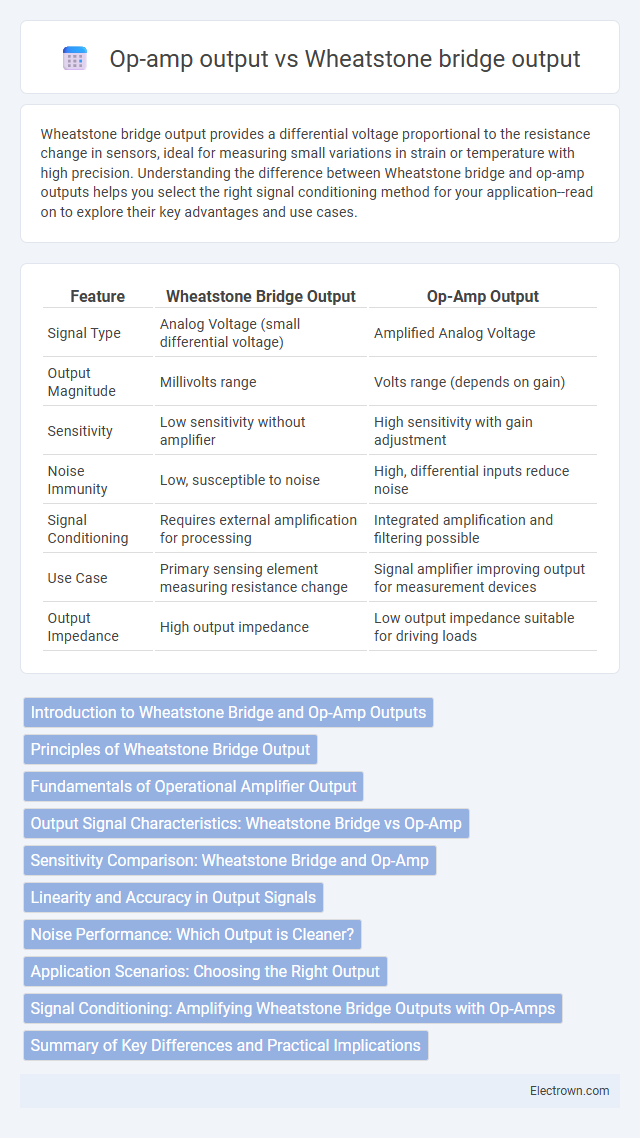Wheatstone bridge output provides a differential voltage proportional to the resistance change in sensors, ideal for measuring small variations in strain or temperature with high precision. Understanding the difference between Wheatstone bridge and op-amp outputs helps you select the right signal conditioning method for your application--read on to explore their key advantages and use cases.
Table of Comparison
| Feature | Wheatstone Bridge Output | Op-Amp Output |
|---|---|---|
| Signal Type | Analog Voltage (small differential voltage) | Amplified Analog Voltage |
| Output Magnitude | Millivolts range | Volts range (depends on gain) |
| Sensitivity | Low sensitivity without amplifier | High sensitivity with gain adjustment |
| Noise Immunity | Low, susceptible to noise | High, differential inputs reduce noise |
| Signal Conditioning | Requires external amplification for processing | Integrated amplification and filtering possible |
| Use Case | Primary sensing element measuring resistance change | Signal amplifier improving output for measurement devices |
| Output Impedance | High output impedance | Low output impedance suitable for driving loads |
Introduction to Wheatstone Bridge and Op-Amp Outputs
The Wheatstone bridge output is a differential voltage signal typically in the millivolt range, representing the balance of resistances within the circuit and is commonly used for precise measurement of unknown resistors or sensor elements like strain gauges. An operational amplifier (op-amp) output provides a voltage level that can be significantly amplified, offering high gain, high input impedance, and low output impedance, which enables accurate signal conditioning and noise reduction of small signals from sources like the Wheatstone bridge. The combined use of a Wheatstone bridge with an op-amp output stage enhances overall measurement sensitivity and stability in sensor applications.
Principles of Wheatstone Bridge Output
The Wheatstone bridge output is based on the principle of measuring the imbalance between its four resistive arms, generating a voltage proportional to the change in resistance caused by physical parameters like strain or temperature. Unlike op-amp output, which amplifies input voltage signals through internal stages, the Wheatstone bridge produces a differential voltage inherently sensitive to small resistance variations. Your selection depends on the application; the Wheatstone bridge excels in precise sensor signal generation before amplification by an op-amp for further processing.
Fundamentals of Operational Amplifier Output
The Wheatstone bridge output typically provides a small differential voltage proportional to resistance changes, requiring precise measurement techniques. An operational amplifier (op-amp) amplifies this small differential voltage with high input impedance and low output impedance, ensuring accurate signal conditioning. The fundamental op-amp output characteristics include linear voltage gain, low distortion, and the ability to drive various load impedances while maintaining signal integrity.
Output Signal Characteristics: Wheatstone Bridge vs Op-Amp
The Wheatstone bridge produces a differential voltage output proportional to resistance changes, typically in the millivolt range, requiring precise amplification for further processing. Op-amp outputs deliver amplified, single-ended signals with high gain, low noise, and adjustable offset, enabling easier interfacing with digital systems. Wheatstone bridge outputs are inherently low-level and sensitive to temperature variations, while op-amps provide stabilized, linearized signals suitable for sensor conditioning and accurate measurement applications.
Sensitivity Comparison: Wheatstone Bridge and Op-Amp
The Wheatstone bridge offers high sensitivity in measuring small resistance changes due to its balanced bridge configuration, making it ideal for precise strain gauge and sensor applications. Op-amps amplify differential signals from the Wheatstone bridge output, enhancing overall system sensitivity by providing gain and noise reduction. Combining both enables detection of minute variations with improved accuracy and resolution compared to using a Wheatstone bridge or op-amp alone.
Linearity and Accuracy in Output Signals
Wheatstone bridge output offers high linearity in detecting resistance changes, making it ideal for precise sensor measurements, but its output voltage levels are often low and may require amplification for accurate reading. An op-amp output enhances the signal by providing both amplification and improved linearity over a wider dynamic range, ensuring better accuracy and noise rejection in your measurements. Combining a Wheatstone bridge with a carefully selected op-amp maximizes the fidelity and reliability of output signals in sensitive instrumentation.
Noise Performance: Which Output is Cleaner?
The Wheatstone bridge output is inherently low-level and susceptible to noise, often requiring amplification for practical sensor applications. Operational amplifier (op-amp) outputs provide higher signal levels with built-in gain and filtering capabilities, resulting in significantly cleaner and more stable signals. Using precision instrumentation amplifiers with Wheatstone bridges enhances noise performance by minimizing common-mode interference and improving overall output signal quality.
Application Scenarios: Choosing the Right Output
Wheatstone bridge output is ideal for precise resistance measurement in sensor applications like strain gauges and temperature sensors, providing raw voltage proportional to resistance changes. Op-amp output enhances signal fidelity through amplification and filtering, making it suitable for low-level signal conditioning in noisy environments and systems requiring higher sensitivity. Your choice depends on whether accurate sensor data acquisition (Wheatstone bridge) or amplified, noise-resistant signals (op-amp output) is critical for your application scenario.
Signal Conditioning: Amplifying Wheatstone Bridge Outputs with Op-Amps
Wheatstone bridge output signals are typically low-level voltage differences that require precise amplification for accurate measurement. Operational amplifiers (op-amps) are ideal for this task due to their high input impedance and ability to provide stable gain, effectively conditioning the Wheatstone bridge output for further processing or digital conversion. Your measurement system benefits from using op-amps to amplify these small signals without introducing significant noise or distortion.
Summary of Key Differences and Practical Implications
The Wheatstone bridge output provides a differential voltage signal proportional to resistance changes, ideal for precise sensor measurements but with limited amplification and noise rejection. In contrast, an op-amp output delivers amplified, single-ended voltage, enhancing signal strength and enabling easier interfacing with analog-to-digital converters. Practical implications include using Wheatstone bridges for sensitive strain gauges or temperature sensors, while op-amps are essential for signal conditioning and improving measurement accuracy in noisy environments.
Wheatstone bridge output vs Op-amp output Infographic

 electrown.com
electrown.com